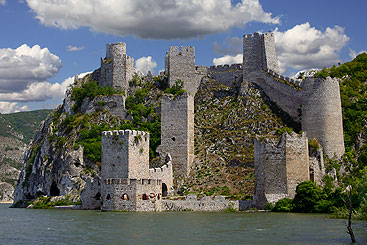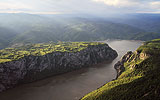Djerdap National Park: standing at the banks of history

Djerdap National Park: standing at the banks of history
Nature and time combine in one of the most beautiful national parks in Europe with one of the oldest geologic histories. The unique biodiversity of the area shares space with the permanent relics of eight thousand years of culture along the Danube.

Golubac Fortress was built in the 14th century, and is remarkably well preserved given its age and location. Its placement at the head of the Iron Gate gorge allowed for easy control of river traffic and made it an important military defence structure.
The djerdap National Park is a unique European nature reserve. It’s the largest national park in Serbia, and is situated in the north-eastern part of the country on the border with Romania. Covering 63,608 hectares along a hundred kilometre stretch on the right bank of the Danube, the park represents the conservation of nature and culture.
The national park is referred to as the ‘river national park’, since the Danube forms such a significant part of the park. One of the most spectacular attractions in the park is the Djerdap Gorge – known as the Iron Gates. It is the largest and longest gorge in Europe, made up of a network of canyons (Golubacka, Gospodjin Vir, Veliki and Mali Kaza) and valleys (Ljubovska, Donjomlanovacka and Orsavska). It is also the place where the Danube is at its deepest (90 metres) and narrowest (150 metres).

The Danube is at its deepest and narrowest as it flows through the Djerdap National Park.
Remarkable biodiversity. Thanks to the shelter of the
Iron Gates, the unique climate and the historical development
of the area, the park is a wealth of biodiversity.
Over 1100 plant species are preserved in the park, such
as hazel trees, nettle, lilac, silver linden, maple and
downy. Djerdap National park is home to 170 species
of birds – such as golden eagle, eagle owl and black
stork – as well as over 50 species of mammals, such as
bear, lynx, wolf and jackal. The freshwater habitats host
catfish, perch, pike, chub river barbell, roach, bream and
carp – as well as Goluback flies, water flowers, dragon-flies, water bugs and many beetles. The meadows and
pastures teem with grasshoppers, crickets and butterflies. Over 70% of the park is covered by woods, which serve
as the ideal home for insects such as stag, longhorn beetles,
fireflies, bark beetles as well as ants and wasps.
However this remarkable biodiversity is at risk since the construction of the Djerdap Power Station, which has changed the flow regime, riverbanks and wildlife. The water level of the dam near Sip rose from 19 metres to 32 metres, submerging rocks that had previously contributed to the creation of eddies and vortices needed by catfish, which would often reach a weight of 100 kilograms. Other species of fish have been permanently lost because of the construction of the Djerdap reservoir – beluga and stellate sturgeon and Black Sea and Danube herring have been replaced by invasive new species from Asia.
dJeRdaP ThRoughouT The ages
Nowhere is nature and culture heritage as intertwined as in the Djerdap Gorge.
The breadth of history can he felt when walking through the Djerdap National Park, where it’s possible to perceive how people have lived for thousands of years on the border of historical winds. Djerdap National Park is a veritable time machine, taking visitors back eight millennia to Lepenski Vir, the Neolithic fishing village that was the centre of one of the most complex prehistoric cultures.
The Romans cut a strategic road through the Djerdap Gorge and built bridges across the Danube. The Tabula Traiana and Diana Fortress are reminders of the power and richness of the Roman Empire.
Legends of the beautiful girl Golubana still live in the Sesir Tower of Golubac Fortress, whose towers and walls stand as a permanent testimony to the architectural skills and knowledge of the medieval Serbian builders and lords.
This valuable trail of the past remains in Djerdap National Park, where 40 sites were registered as immovable cultural properties, along with the four cultural monuments of great importance: Lepenski Vir, Tabula Traiana, Fortress of Diana and the Golubac Fortress.
Protecting valuable resources. The Djerdap National Park was established in 1974 to protect and improve the unique natural and cultural values of the area. The Djerdap National Park was set up as a public enterprise in 1989 to manage the protected area, with its headquarters in Donji Milanovac. The cooperation of the Djerdap National Park extends far beyond the borders of Serbia, however, as the park is part of the family of Europarc Federation of European national parks.
For more information, please visit: www.npdjerdap.org





